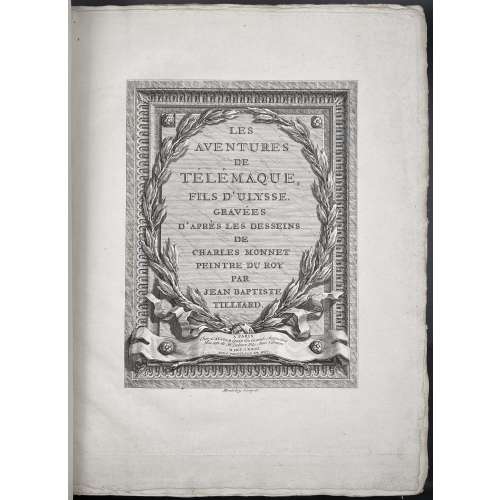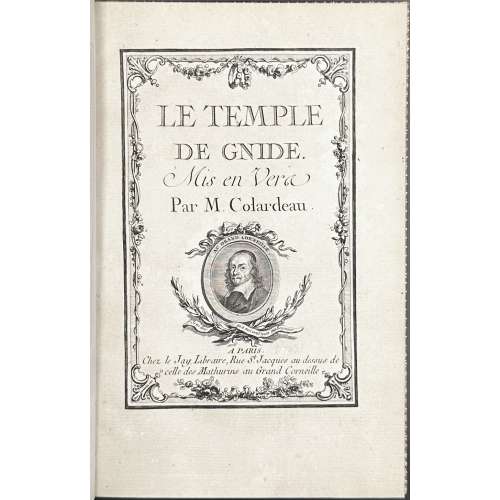The Four Elements by Jacob Matham (Netherlandish, Haarlem 1571–1631 Haarlem) after Hendrick Goltzius (Netherlandish, Mühlbracht 1558–1617 Haarlem). Engraving on copper, printed on laid paper, 1588.
Dimensions: 298 mm × 206 mm.
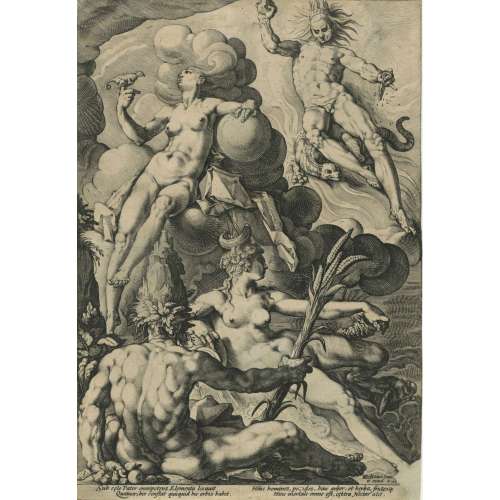
The Four Elements by Jacob Matham (Netherlandish, Haarlem 1571–1631 Haarlem) after Hendrick Goltzius (Netherlandish, Mühlbracht 1558–1617 Haarlem). Engraving on copper, printed on laid paper, 1588.
Dimensions: 298 mm × 206 mm.
![George Cruikshank. George Cruikshank's Fairy Library. Hop-O'-My Thumb. Jack and the Bean-Stalk. Cinderella. Puss in Boots. — London: George Bell and Sons, 1885. — pp.: [2] blank, [2] first half-title with blank verso, [i-ii] second half-title with blank verso, [2] frontispiece plate with blank recto, [iii-viii] title, colophone, editor's note, list of illustr. [2] title with blank verso, [1] 2-101 [3] blank, 24 plates with protective tissue, unpag. — Colophon: This edition is limited to 500 copies, with India paper impressions. The former editions have been from lithographic transfers. The plates were retouched under Mr. Cruikshank's direction shortly before his death, and have not been used since until now.](https://varshavskycollection.com/wp-content/uploads/2021/02/LIB-2454.2020-f-1-500x500.jpeg)
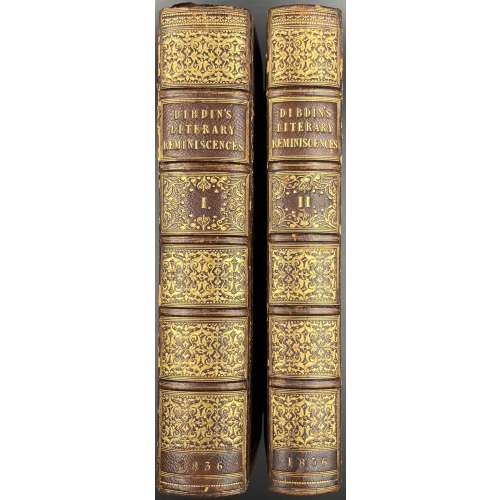
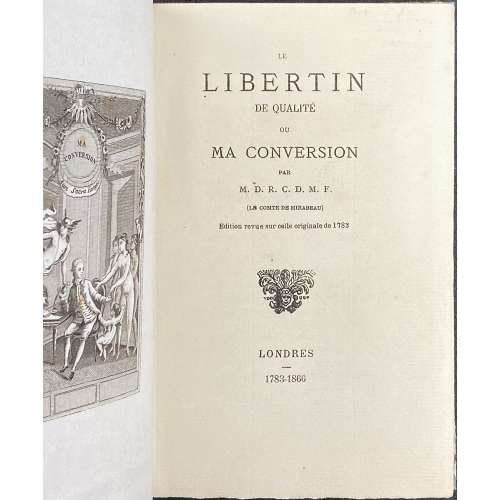
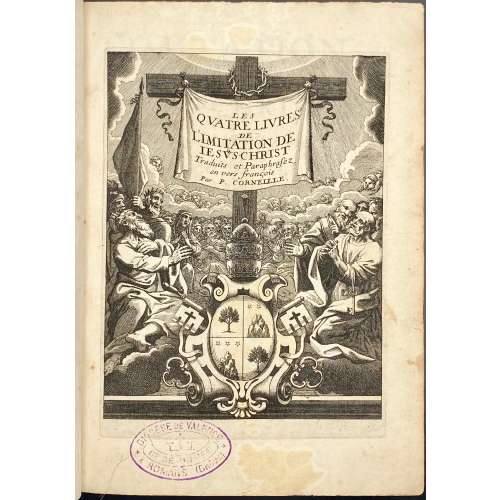
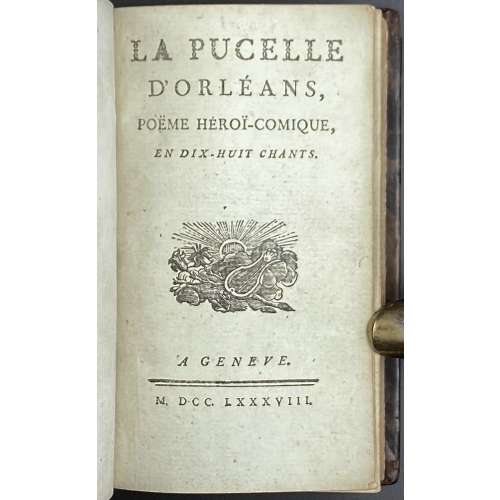
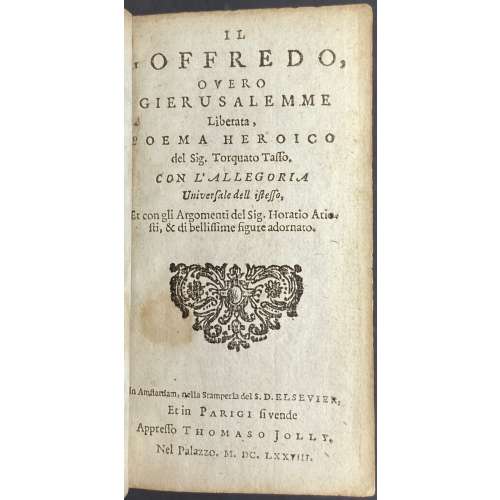
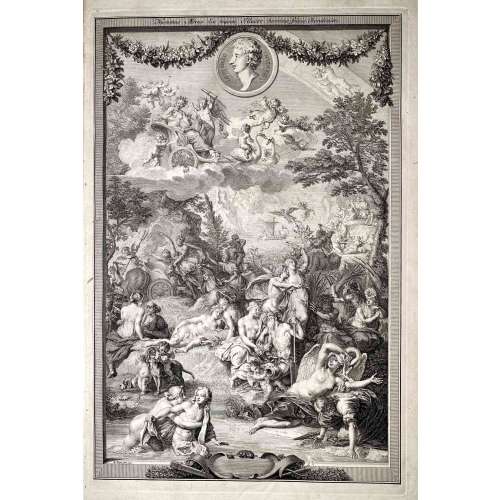
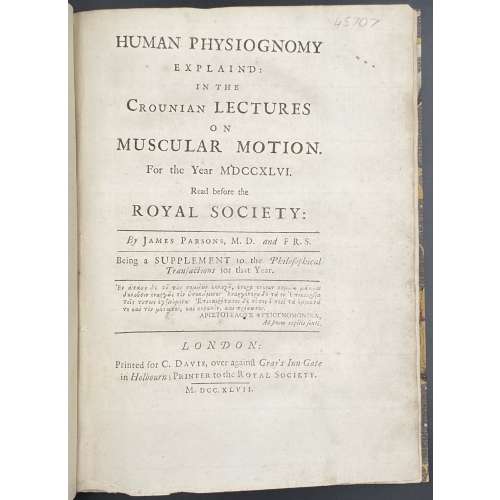
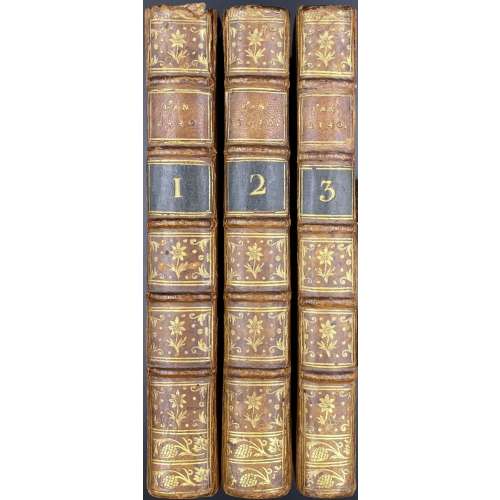
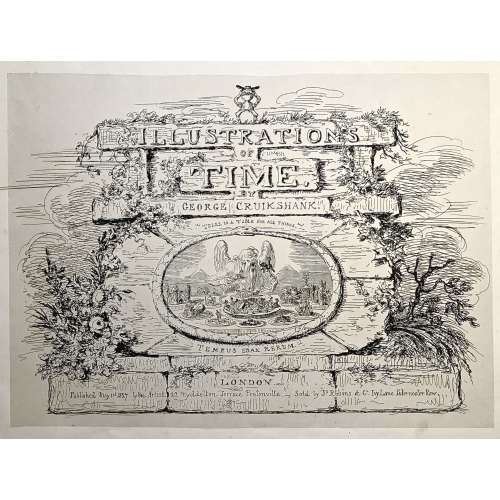
Engraved title page: ILLUSTRATION | OF | TIME. | GEORGE CRUIKSHANK. | "THERE IS A TIME FOR ALL THINGS". | TEMPUS EDAX RERUM. | LONDON | Published May 1st 1827 by the Artist - 22 Myddelton Terrace Pentonville. - Sold by Js. Robins & Co. Ivy Lane Paternoster Row.
Oblong folio, 33.5 x 44 cm. Engraved vignette title page and six not-coloured engraved plates with multiple images showing thirty-five humorous scenes.
First edition, first issue. Uncoloured. Pristine condition.
Half-leather bound in marbled cardboard and red morocco and gild lettering and arabesque. Frontispiece and 6 plates with protective tissues.
Content:1. Time-Called & Time-Come (five sketches)
2. Behind Time (seven sketches)
3. Time Thrown Away (six sketches)
4. Hard Times [&] Term Time (five sketches)
5. Time Badly Employed (five sketches)
6. Christmas Time (seven sketches)
British Museum № 1978,U.3026.1. BM description: "Frontispiece, the title on a background of symmetrical but dilapidated and grass-grown masonry. On the summit stands a little laughing gnome, with a wide hat and a body formed of an hour-glass; Inset is an oval bordered by a serpent with its tail in its mouth (emblem of eternity), in which is an aged and all-devouring Time (bald except for a forelock), seated behind a table whose surface is the base of the design. He puts to his mouth a fork on which is speared an elephant with a castle on its back containing tiny figures with spears. In his r. hand is a spoon containing a country church. His table is covered with dishes, and at his r. hand is a sickle. The central and biggest dish is heaped with a jumble of tiny objects: crown, table, chair, wheelbarrow, picture; round the room sit little figures: a soldier, parson, lady and child, &c. The ten other dishes contain: an antique glass coach with horses and footmen; an overladen camel beside a palm-tree; ruins of a castle; a farmhouse; a shepherd and sheep; a dismantled cannon and balls, cattle, a man-of-war in full sail; a ruinous Gothic cathedral; a clump of trees (the last two are dominated by a large decanter). Below Time are two (Egyptian) pyramids. Above: 'There Is A Time For All Things'; below: 'Tempus Edax Rerum'. 1 May 1827. Etching."![[Barham, Richard Harris]. The Ingoldsby Legends or Mirth and Marvels by Thomas Ingoldsby, esquire / First, Second and Third Series - 3 volumes; Illustr.: George Cruikshank and John Leech. — London: Richard Bentley, 1840-1847. — Vol. 1: Printed by London: Samuel Bentley, 1840. pp.: ff, [2 blank] [i ht] [ii colophon] [title, verso blank] [iii] iv-v [vi blank] [contents, list of ill.] [blank, etching on verso] [1] 2-338 [339] [7, incl. orig. FC and Sp.] bf, 6 plates: 1 by Buss, 3 by Leech, 2 by Cruikshank. — Vol. 2: Printed by London: S. & J. Bentley, Wilson, and Fley, 1842. pp.: ff, [2 blank] [i ht] [ii colophon] [title, verso blank] [v] vi-vii [viii blank] [contents, verso blank] [blank, etching on verso] [1] 2-288 [6, incl. orig. FC and Sp.] bf, 7 plates: 3 by Leech, 4 by Cruikshank. — Vol. 3: Printed by London: S. & J. Bentley, Wilson, and Fley, 1847. pp.: ff, [2 blank] [i ht] [ii colophon] [title, verso blank] [iii] iv-vi [contents, list of ill.] [blank, portrait on verso] [1] 2-364 [6, incl. orig. FC and Sp.] bf, 6 plates: 2 portraits, 2 by Leech, 2 by Cruikshank.](https://varshavskycollection.com/wp-content/uploads/2021/02/LIB-2483-1.2020-c-1-500x500.jpeg)
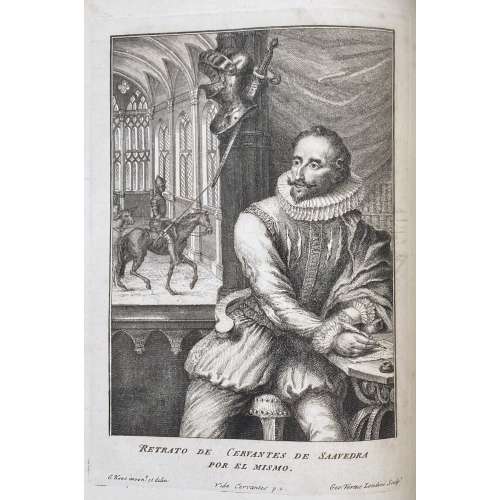
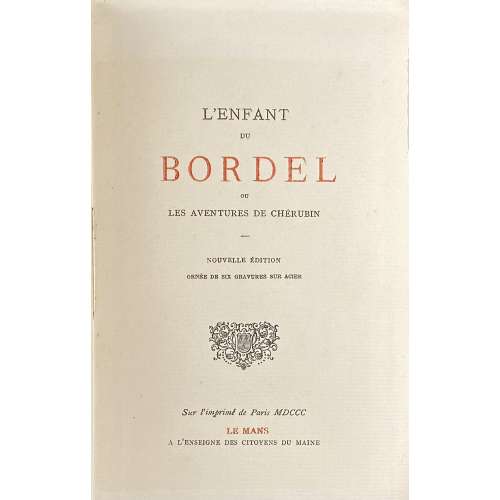
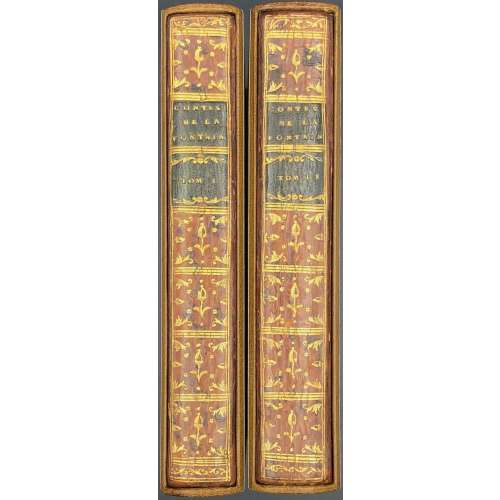
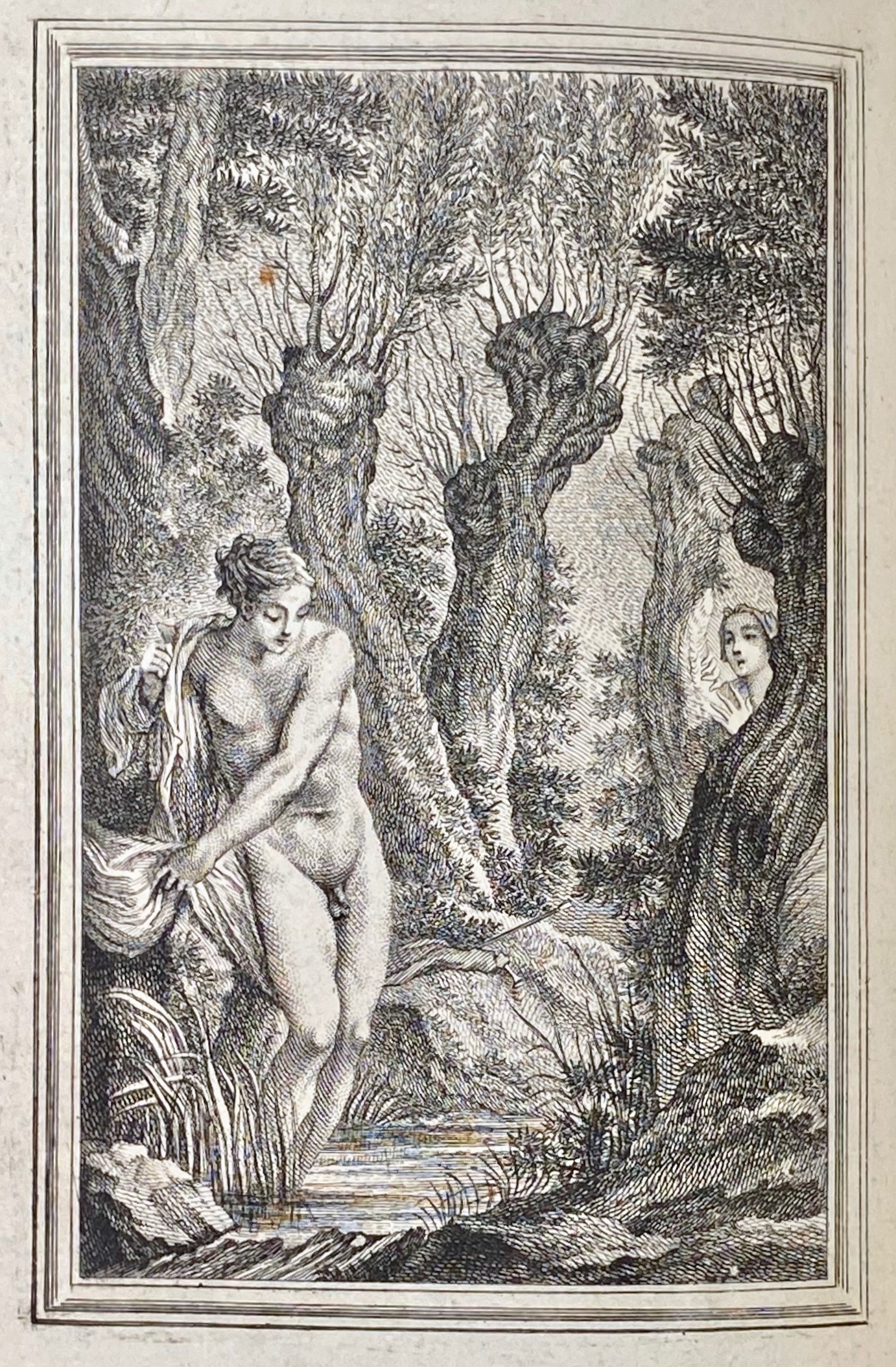
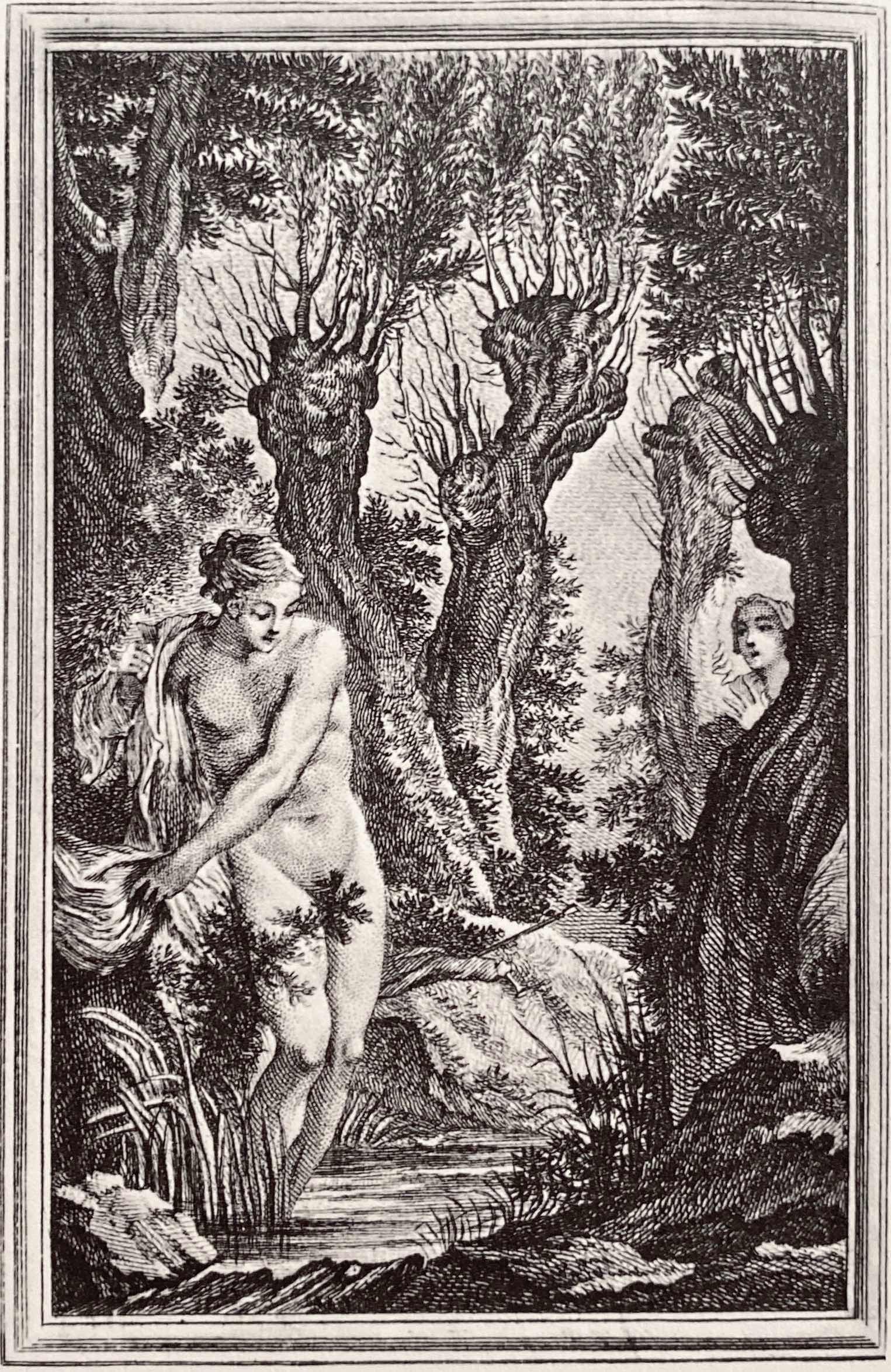 Contributors:
Jean de La Fontaine (French, 1621–1695) – author.
Fermiers généraux and Jean Baptiste Séroux d'Agincourt (French, 1730 – 1814) – publisher.
Joseph Gérard Barbou (French, 1723–1790) – printer.
Artists:
Charles Eisen (French, 1720 – 1778)
François Xavier Vispré (British-French, c.1730 – 1789 or after)
Hyacinthe Rigaud [Jacint Rigau-Ros i Serra] (Catalan-French, 1659 – 1743)
Engravers:
Joseph de Longueil (French, 1730 – 1792)
Noël Le Mire (French, 1724 – 1801)
Jean-Jacques André Le Veau (French, 1729 – 1786)
Jacques Aliamet (French, 1726 – 1788)
Jean Charles Baquoy (French, 1721 – 1777)
Pierre-Philippe Choffard (French, 1730 – 1809)
Jean Jacques Flipart (French, 1719 – 1782)
Louis Simon Lempereur (French, 1725 – 1796)
Jean Ouvrier (French, 1725 – 1784)
Contributors:
Jean de La Fontaine (French, 1621–1695) – author.
Fermiers généraux and Jean Baptiste Séroux d'Agincourt (French, 1730 – 1814) – publisher.
Joseph Gérard Barbou (French, 1723–1790) – printer.
Artists:
Charles Eisen (French, 1720 – 1778)
François Xavier Vispré (British-French, c.1730 – 1789 or after)
Hyacinthe Rigaud [Jacint Rigau-Ros i Serra] (Catalan-French, 1659 – 1743)
Engravers:
Joseph de Longueil (French, 1730 – 1792)
Noël Le Mire (French, 1724 – 1801)
Jean-Jacques André Le Veau (French, 1729 – 1786)
Jacques Aliamet (French, 1726 – 1788)
Jean Charles Baquoy (French, 1721 – 1777)
Pierre-Philippe Choffard (French, 1730 – 1809)
Jean Jacques Flipart (French, 1719 – 1782)
Louis Simon Lempereur (French, 1725 – 1796)
Jean Ouvrier (French, 1725 – 1784)
Étienne Ficquet (French 1719 – 1794)
Catalogue raisonné: Ray (French): №26, pp. 54-56; Cohen-DeRicci: 558-571; Lewine: 278-280.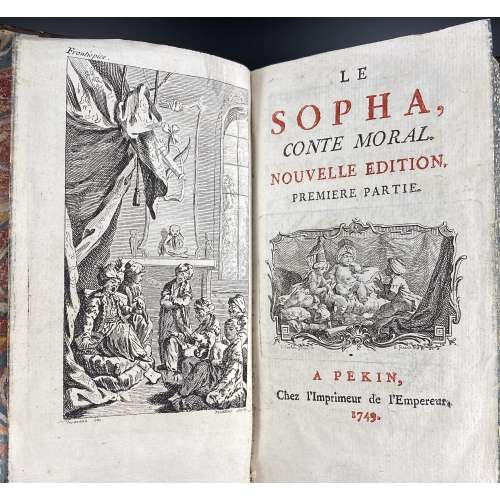
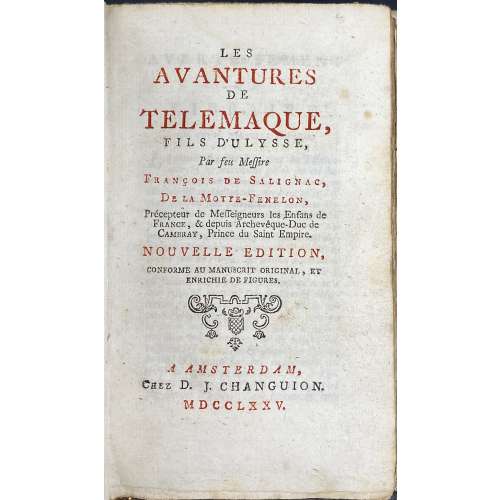
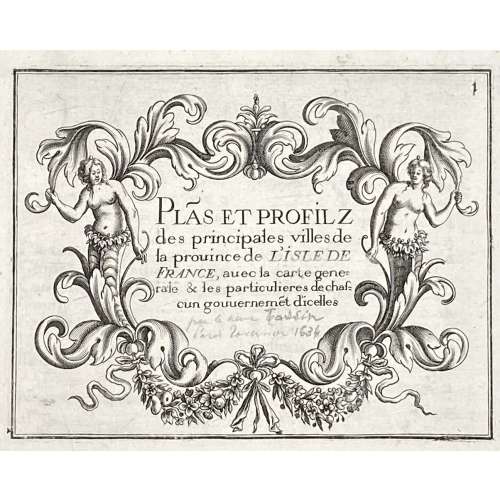
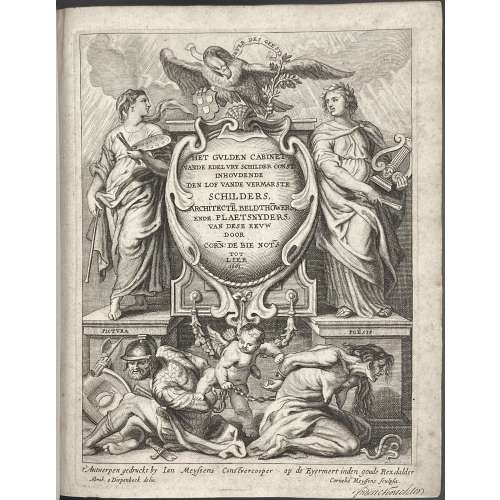
Cornelis de Bie. Het Gulden Cabinet. — Antwerp: [J. van Montfort for] Jan Meyssens, 1661 [colophon: 1662]. First edition, quarto, with engraved title, added portrait of De Bie dated 1708 mounted and inserted*, illustrated with 97 full-page engravings of artists, and an engraving of a personification of the city of Rome repeated five times; bound in full contemporary Dutch parchment over boards, tooled in blind, titled on spine; ex libris Frederik Verachter (Dutch, 1797 – 1870), archivist of the Antwerp city library, with pages of notes in his hand, signature to title, and inserted leaf with extra biographical information about one of the 280 artists of the Low Countries profiled and illustrated in this volume; contents good; ex libris Gustave Van Havre (Dutch, 1817 – 1892), with his armorial bookplate inside the front board, 24 x 19.5 x 4.5 cm.
Catalogue raisonné: J. F. Van Someren (1888) pp. 200-202. * CORNELIUS DE BIE. ÆT. 81. 1708. | Dat Ick op D'aard Niet Anders Ben | Als Stof En Assen Ick Beken: | En Alle Mijnen Arrebeijd | Noch Van Veel Minder Weerdigheijt. || J. C. de Cock delin: — H. F. diamaer Sculpsit Antv: Ref.: Royal Collection Trust. Backer, Jacob de (Flemish, c. 1555 – c. 1585) (artist) Balen, Jan van (Flemish, 1611 – 1654) (artist) Bally, David (Dutch, 1584 – 1657) (artist) Beck, David [Beek] (Dutch, 1621 – 1656) (artist) Bie, Cornelis de (Flemish, 1627 – 1711) (author) Bloemaert, Abraham (Dutch, 1565 – 1658) (artist) Borcht I, Hendrik van der, the Elder (Flemish, 1583 – 1651) (artist) Borcht II, Hendrik van der, the Younger (German 1614 – 1676) (artist) Bouttats, Frederik, the Elder (Flemish, 1590 – 1661) (attributed to) (engraver) Bramer, Leonard [Leendert] (Dutch, 1596 – 1674) (artist) Bronckhorst, Jan Gerritsz van (Dutch, 1603-1661) (artist) Bylert, Jan van (Dutch, 1603 – 1671) (artist) Caukercken, Cornelis van (Flemish, 1626 – 1680) (engraver) Collin, Richard (Luxembourgish, 1627 – 1698) (engraver) Coques, Gonzales (Flemish, 1614 – 1684) (artist) Cossiers, Joannes (Flemish, 1600 – 1671) (artist) Danckerts de Rij, Peter (Dutch, 1605-1660) (artist) Dipenbeeck, Abraham van (Dutch, 1596 – 1675) (artist) Does, Antony van der (Flemish, 1609 –1680) (engraver) Dyck, Anthony van (Flemish, 1599 – 1641) (artist) François, Pierre (fl. 1643) (artist) Hecke, Jan van den, the Elder (Flemish, 1620 – 1684) (engraver) Heil, Daniel van (Flemish, 1604 – 1664) (artist) Heil, Jan Baptiste van (Flemish, 1609 – 1685) (artist) Heil, Leo van (Flemish, 1605 – c. 1664) (artist) Helt Stockade, Nicolaes van (Dutch, 1614 – 1669) (artist) Hollar, Wenceslaus [Hollar, Václav; Wenzel] ( Bohemian, 1607 – 1677) (artist) Hondius I, Hendrick [de Hondt] (Flemish-Dutch, 1573 – 1650) (artist) Janssens, Cornelis van Ceulen [Johnson, Cornelius] (Flemish-Dutch, 1593-1664) (artist) Jode I, Pieter de, the Elder (1570 – 1634) (engraver) Jordaens, Jacob (Flemish, 1593 – 1678) (artist) Lint, Peter van (Flemish, 1609 – 1690) (artist) Meyssens, Cornelis (Flemish, 1639 – fl.1673) (engraver) Meyssens, Joannes [Johannes, Jan, Jean] (Flemish, 1612 – 1670) Mola, Pier Francesco (Italian, 1612 – 1666) (artist) Monte, Deodat del [Mont, Deodat van der; Delmont, Deodatus] (Flemish, 1582 – 1644) (artist) Montfort, Jan van (fl. c. 1595 – 1644) (printer) Padoanino, Francisco (Italian, 1660) (artist) Poelenburgh, Cornelis van [Poelenburch] (Dutch, 1594 – 1667) (artist) Pontius, Paulus (Flemish, 1603 – 1658) (engraver) Quellinus, Erasmus, the Younger (Flemish, 1607 – 1678) (artist) Reni, Guido (Italian, 1575 – 1642) (artist) Sadeler II, Egidius (Flemish, c.1570 – 1629) (artist) Saftleven, Herman, the Younger (Dutch, 1609 – 1685) (artist) Seghers, Gerard (Flemish, 1591 - 1651) (artist) Snyers, Hendrik (Flemish, 1611 – 1644) (engraver) Soutman, Pieter Claesz (Dutch, 1593/1601 – 1657) (artist) Steen, Franciscus van der (Flemish, 1625 – 1672) (engraver) Teniers, David, the Younger (Flemish, 1610 – 1690) (artist) Venne, Adriaen van de [Adriaen Pietersz] (Dutch, 1589 – 1662) (artist) Voet, Alexander, the Elder (Flemish, 16-8/1613 – 1689) (engraver) Vorsterman, Lucas, the Elder (Flemish, 1595-1675) (engraver) Waumans, Conraed (Flemish, 1619 – 1675) (engraver) Willaerts, Adam (Dutch, 1577 – 1664) (artist)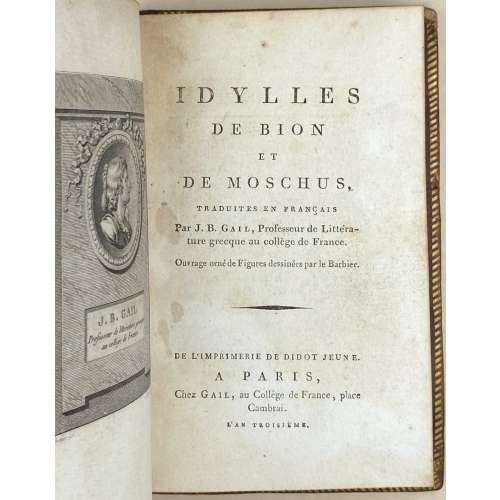
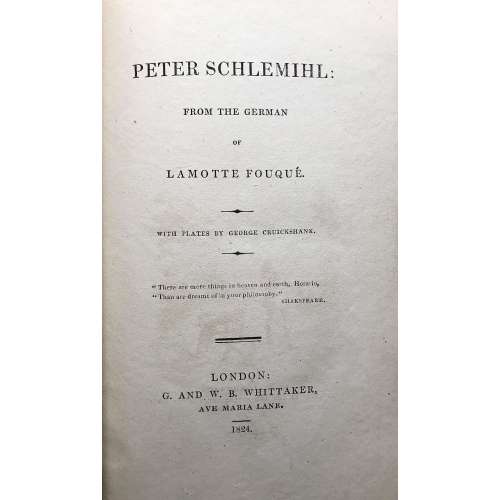
In a cover box of red cloth over cardboard. Box: 21 x 13 x 2.3 cm; book: 19.3 x 11.8 x 1.7 cm; Crown 8vo. Red cardboard binding. Printed spine labels mounted on spine of the box and the book. Untrimmed edges.
Reference: Cohn 475.![George Cruikshank's table-book / edited by Gilbert Abbott à Beckett. – London: Punch office, 1845. – viii, 284 p., [12] leaves of plates : ill's.](https://varshavskycollection.com/wp-content/uploads/2021/02/LIB-2557.2020-5-500x500.jpeg)
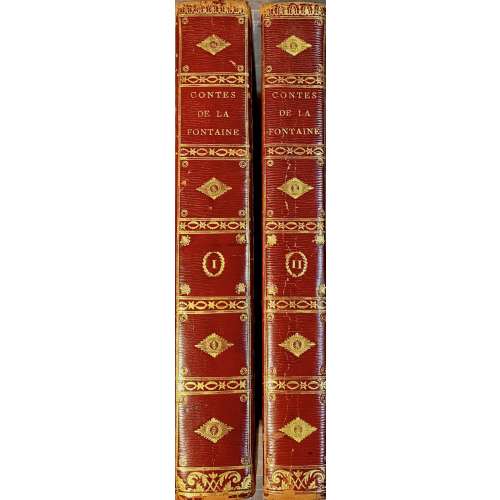
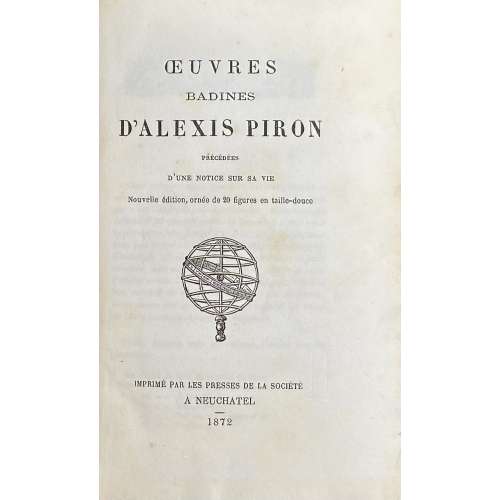
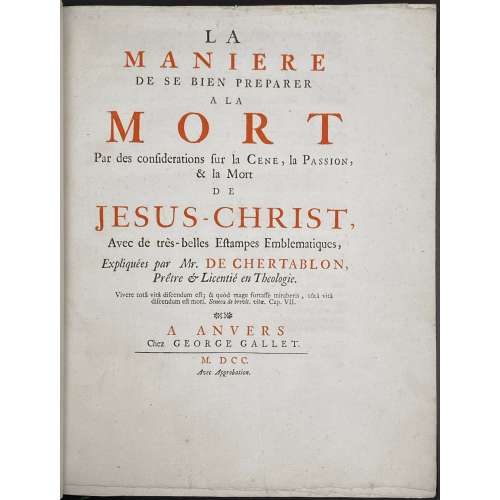
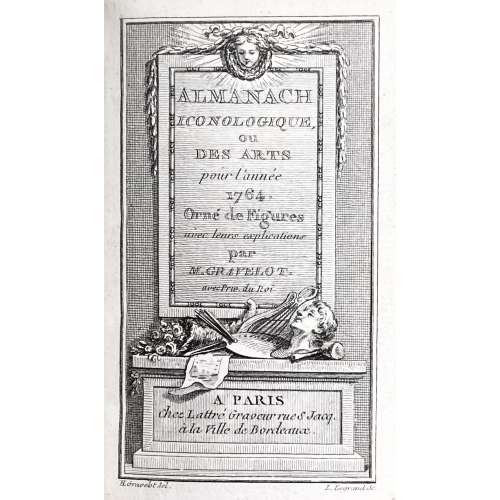
Engraved title:
Upper frame: ALMANACH | ICONOLOGIQUE, | OU | DES ARTS | pour l'année | 1764. | Orné de Figures | avec leurs explications | par | M. GRAVELOT. | avec Priv. du Roy | A PARIS
Lower frame: Chez Lattré Graveur rue S. Jacq. | à la Ville de Bordeaux.
Under the frame: H. Gravelot del. — L. Legrand sc.
28 leaves, of them: engraved t.p., engraved frontis., and 12 plates, text engraved. Pages numbered 1-12, and I-XII (incorrectly marked XVI), other unpaginated, unbound tissue guards. Size: 10.6 x 7.2 cm, full polished crimson calf w/veins, triple-ruled in gilt with florets in corners, flat spine, double-ruled in gilt, all edges gilt. Florets in compartments, black title label with gilt lettering “ALM | ICON ||”, peacock marbled endpapers, blue silk ribbon. Approbation dated 15 November 1763, as some plates.
Catalogue raisonné: Cohen, De Ricci 454.
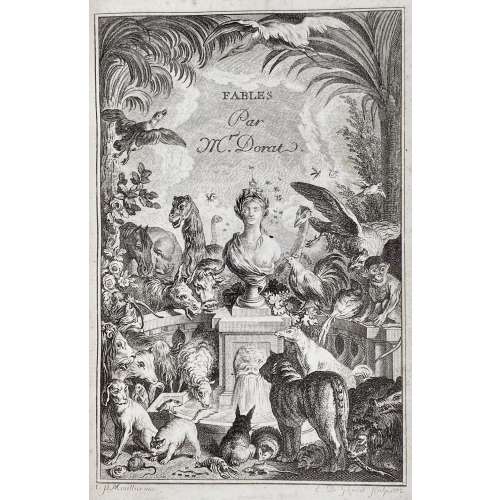
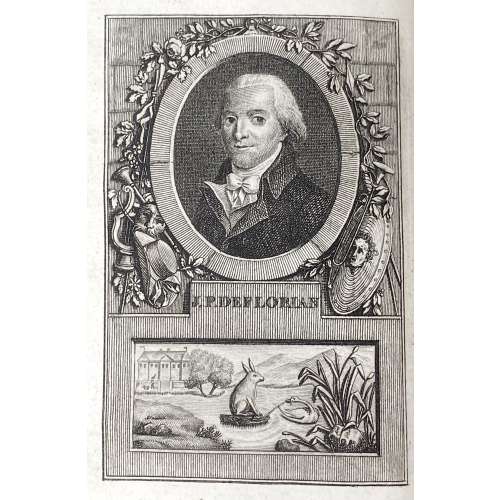
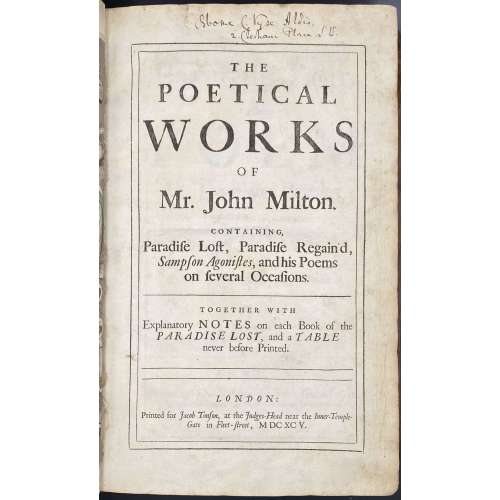
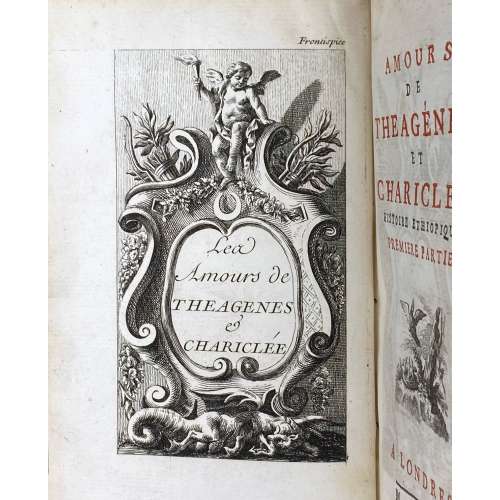
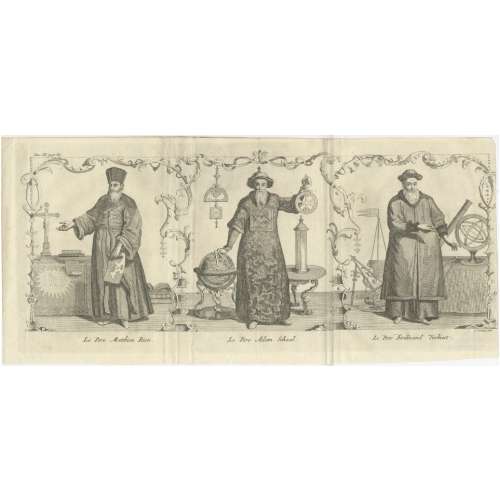
Three priests: Le Pere Matthieu Ricci, Le Pere Adam Schaal, and Le Pere Ferdinand Verbiest. Three priests with navigational instruments. Image taken from Description geographique, historique, chronologique et physique de l'Empire de la Chine et de la Tartarie Chinoise. Enrichies des cartes generales et particulieres de ces pays, etc. by Jean-Baptiste Du Halde (1674–1743), vol. 3, page 78. Originally published/produced in La Haye [The Hague], 1736. J.v.Solingen fecit
Jean-Baptiste Du Halde (Chinese: 杜赫德; 1 February 1674 – 18 August 1743) was a French Jesuit historian specializing in China. He did not travel to China, but collected seventeen Jesuit missionaries' reports and provided an encyclopedic survey of the history, culture and society of China and "Chinese Tartary," that is, Manchuria. Voltaire said of Du Halde's work: "Although it is developed out of Paris, and he hath not known the Chinese, [he] gave on the basis of the memoirs of his colleagues, the widest and the best description the empire of China has had worldwide." Le Pere Matthieu Ricci, a.k.a. Matteo Ricci, S.J. (Italian pronunciation: [matˈtɛːo ˈrittʃi]; Latin: Mattheus Riccius Maceratensis; 6 October 1552 – 11 May 1610), was an Italian Jesuit priest and one of the founding figures of the Jesuit China missions. His 1602 map of the world in Chinese characters introduced the findings of European exploration to East Asia. He is considered a Servant of God by the Roman Catholic Church. Ricci arrived at the Portuguese settlement of Macau in 1582 where he began his missionary work in China. He became the first European to enter the Forbidden City of Beijing in 1601 when invited by the Wanli Emperor, who sought his services in matters such as court astronomy and calendrical science. He converted several prominent Chinese officials to Catholicism, such as Xu Guangqi, who aided in translating Euclid's Elements into Chinese as well as the Confucian classics into Latin for the first time. Le Pere Adam Schaal, a.k.a. Johann Adam Schall von Bell (1 May 1591 – 15 August 1666) was a German Jesuit and astronomer. He spent most of his life as a missionary in China (where he is remembered as "Tang Ruowang") and became an adviser to the Shunzhi Emperor of the Qing dynasty. Le Pere Ferdinand Verbiest, a.k.a. Father Ferdinand Verbiest (9 October 1623 – 28 January 1688) was a Flemish Jesuit missionary in China during the Qing dynasty. He was born in Pittem near Tielt in the County of Flanders (now part of Belgium). He is known as Nan Huairen (南懷仁) in Chinese. He was an accomplished mathematician and astronomer and proved to the court of the Kangxi Emperor that European astronomy was more accurate than Chinese astronomy. He then corrected the Chinese calendar and was later asked to rebuild and re-equip the Beijing Ancient Observatory, being given the role of Head of the Mathematical Board and Director of the Observatory. He became close friends with the Kangxi Emperor, who frequently requested his teaching, in geometry, philosophy and music. Verbiest worked as a diplomat and cartographer, and also as a translator because he spoke Latin, German, Dutch, Spanish, Hebrew, and Italian. He wrote more than thirty books. During the 1670s, Verbiest designed what some claim to be the first ever self-propelled vehicle – many claims this as the world's first automobile, in spite of its small size and the lack of evidence that it was actually built.Joshua Van Solingen was an engraver and publisher from Holland, working, besides other places, in Scotland. Information about him can be found at Catastrophic Bliss (The Griot Project Book Series) by Accounting in Scotland (RLE Accounting): A Historical Bibliography History of the Scottish Metrical Psalms: With an Account of the Paraphrases ... The History of Edinburgh, from the Earliest Accounts to the Present Time ... History of the Bassandyne Bible, the First Printed in Scotland: With Notices ...
![George Cruikshank's omnibus / edited by Laman Blanchard. – London : Tilt and Bogue, 1842. – [2], vi, [2], [2] 300 p., [22] leaves of plates : ill's.](https://varshavskycollection.com/wp-content/uploads/2021/02/LIB-2558.2020-6-500x500.jpeg)
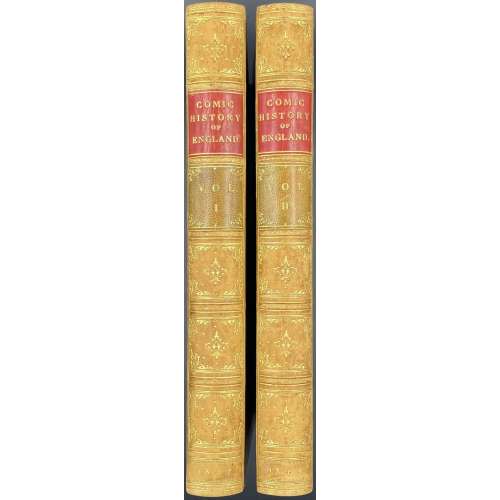
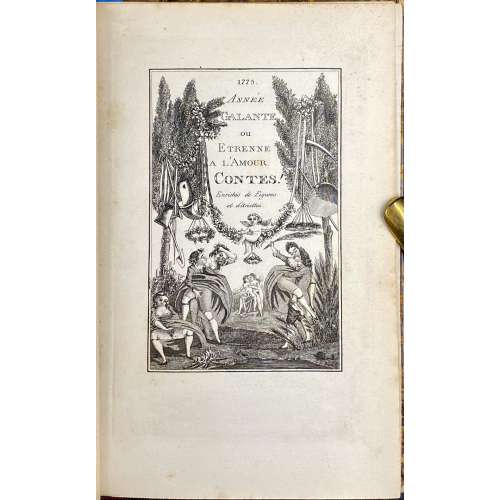
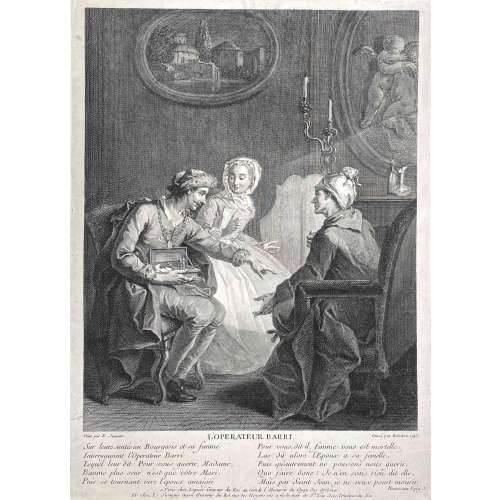
Engraving by J.J. Balechou after E. Jeaurat. A husband and wife ask a quack doctor for advice about health: he suggests substituting himself for the husband in the wife's affections, and she agrees: Épigrammes de Jean-Baptiste Rousseau (French, 1671–1741).
Date: 1743.
Size: 380 x 270 mm
Inscriptions under the image:
Top: Peint par E. Jeaurat | L'Operateur Barri | Grave par Balechou 1743
Middle: Sur leurs santés un Bourgeois et sa femme
Interrogeoient l'Operateur Barri, Lequel leur dit : Pour vous guérir, Madame, Baume plus sûr n'est que votre Mari, Puis se tournant vers l'époux amaigri, Pour vous, dit il, femme vous est mortelle, Las ! dit alors l'Epoux à sa femelle, Puis qu'autrement ne pouvons nous guérir, Que faire donc ? Je n'en sçai rien, dit elle,Mais, par Saint Jean, je ne veux point mourir.
Rousseau Epig. X
Center bottom: a Paris chez Lepicie Graveur du Roi au coin de l'Abreuvoir du Quay des Orfevres. Et Chez L. Surugue Aussi Graveur du Roi rue des Noyers vis a vis le mur de St. Yves Avec Privilege du Roi.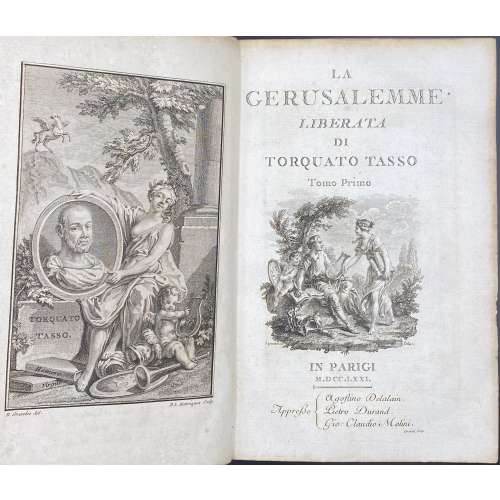
Title: LA | GERUSALEMME | LIBERATA | DI | TORQUATO TASSO | Tomo Primo | {vignette} | IN PARIGI | M.DCC.LXXI | Appreßo { Agostino Delalain. | Pietro Durand. | Gio: Claudio Molini. | Droüet ∫crip.
Pagination: ffl [1] 2-331 [332] bfl; illustrations after Gravelot: frontis. by Henriquez, t.p. vignette by Patas, engraved dedication by Le Roy, 10 head- and 7 tailpieces by Le Roy, 5 full-page vignettes by Le Roy, and 10 plates by: Baquoy, Duclos (3), Le Roy, Lingée, Née, Rousseau, and Simonet (2).
Collation: 8vo; A-V8 X6.
Vol. 2: Title: LA | GERUSALEMME | LIBERATA | DI | TORQUATO TASSO | Tomo Secondo | {vignette} | IN PARIGI | M.DCC.LXXI | Appreßo { Agostino Delalain. | Pietro Durand. | Gio: Claudio Molini. | Droüet ∫crip. Pagination: ffl [1] 2-340 bfl; illustrations after Gravelot: frontis. by Henriquez, t.p. vignette by Mesnil, 10 head- and 6 tailpieces by Le Roy, 4 full-page vignettes by Le Roy, tailpiece by Ponce, and 10 plates by: Duclos, Henriquez, Leveau, Lingée, Massard, Née, Patas, Ponce, Rousseau, and Simonet. Collation: 8vo; A-X8 Y2. Size: 21.5 x 14.5 cm. Size of the copy sold at Sotheby's in 2015: 23.3 x 14.0 cm; Christie's in 2008: 23.2 x 14.4 cm Page size: 21 x 13.5 cm. In referenced sources, the page size is bigger than that. N. Ray gives 11 ½ x 8 7⁄8 inches or 9 x 5½ inches. Cohen and De Ricci do not bother to give sizes, considering that octavo is octavo. MFA: 30.3 x 23.1 x 4 cm (11 15/16 x 9 1/8 x 1 9/16 in.) Binding: Two volumes uniformly bound in full marbled calf, ruled in gilt, flat spine with gilt decorations and monogram, cream lettered label. Geoffrey Lord Cross of Chelsea [Geoffrey Cross, Baron Cross of Chelsea] (British, 1904 – 1989) bookplate to front pastedown. Catalogue raisonné: N. Ray №22, p. 48; Cohen De Ricci 974-975 According to MFA printing by: François-Augustin Quillau (French, 1743–1804). This edition was illustrated by Hubert François Gravelot (French, 1699–1773) and engraved by the following engravers: Jean Charles Baquoy (French, 1721–1777) Antoine Jean Duclos (French, 1742–1795) Benoît Louis Henriquez (French, 1732–1806) Jean Jacques André Le Veau (French, 1729–1785) Charles Louis Lingée (French, 1748–1819) Jacques Le Roy (French, born in 1739) Jean Massard (1740–1822) Elie du Mesnil (French, born about 1728) François Denis Née (French, 1735–1818) Charles Emmanuel Jean Baptiste Patas (French, 1744–1802) Nicholas Ponce (French, 1746–1831) Jean François Rousseau (French, born in 1740) Jean Baptiste Simonet (French, 1742–1813) Droüet (French, 18th century)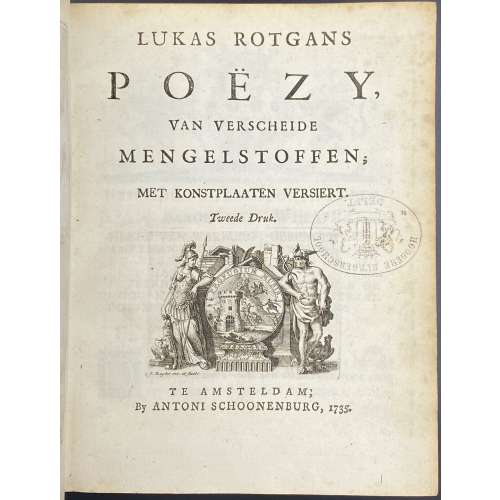
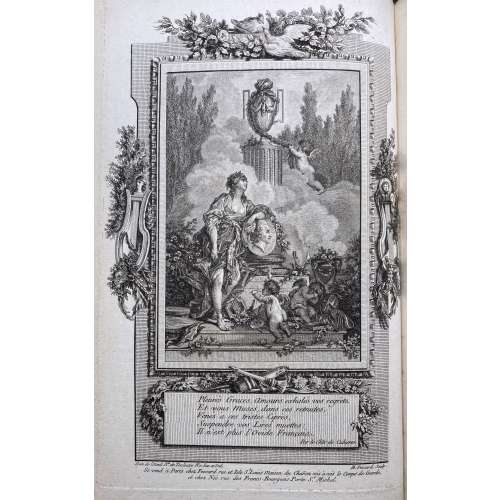
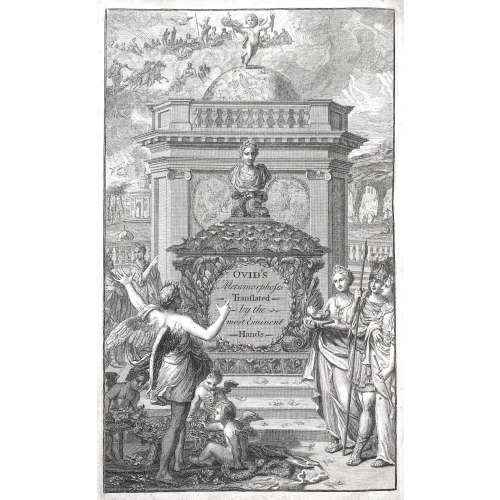
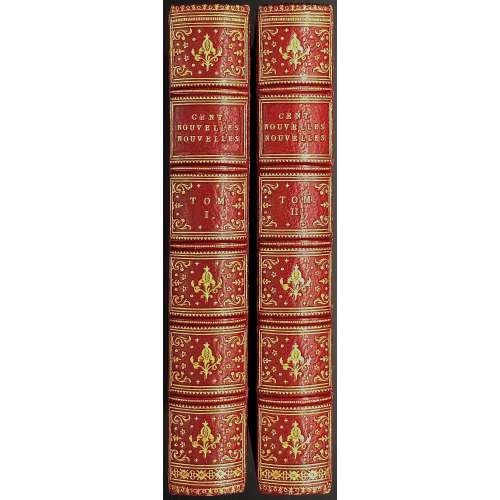
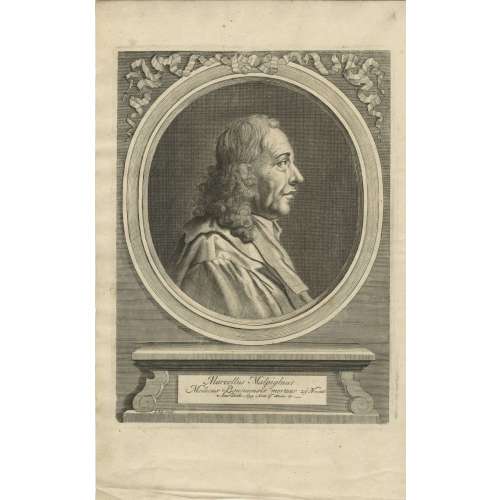
A portrait of Marcello Malpighi from his book Opera posthuma: figuris aeneis illustrata, quibus praefixa est ejusdem vita a seipso scripta, Londini:Churchill, 1697. Inscription: Marcellus Malpighius | Medicus Bononiensis mortuus 29 Novemb. Anno Dom. 1694. Anno aetatis 67. I. Kip. sculp.
Marcello Malpighi (10 March 1628 – 29 November 1694) was an Italian biologist and physician, who is referred to as the "Father of microscopical anatomy, histology, physiology and embryology" [Wikipedia].
From European Journal of Anatomy 22(5):433-439 · September 2018, an article by Sanjib Ghosh and Ashutosh Kumar 'Marcello Malpighi (1628-1694): Pioneer of microscopic anatomy and exponent of the scientific revolution of the 17th Century': Italian anatomist and an eminent scientist who significantly contributed to the advancement of the anatomical sciences in the 17th century. Malpighi was one of the first to use the compound microscope (an instrument designed by Galileo in 1609) and made the most important discovery of his life in 1661 when he identified capillaries as connecting vessels between small arteries and veins in the lungs. Malpighi thus provided the missing link in William Harvey's theory of blood circulation. He made significant contributions in the field of embryology based on his observations on chick embryo, and his efforts provided deep insights into the development of the heart and the nervous system. His communications based on microscopic studies scripted valuable details on the structural organization of organs like the liver, kidney and spleen. He identified the hepatic lobule as the fundamental unit of the liver and noted that bile was being secreted by these lobules and not from the gall bladder (the popular belief then). In the kidney, he discovered the glomerulus (Malpighian Corpuscle) and was the first to observe the convoluted tubules in the renal cortex. He was the first to describe the presence of lymphatic bodies (Malpighi's Corpuscle) in the spleen. Although he was exceedingly successful in his scientific activities, his life was fraught with unfortunate events and savage criticism from detractors arising out of professional jealousy and personal feuds. Nevertheless, his exploits were instrumental in understanding the human microscopic anatomy (histology) and his accomplishments have etched his name in the pages of medical science forever.
The portrait was engraved by Johannes "Jan" Kip (1652/53, Amsterdam – 1722, Westminster) - a Dutch draftsman, engraver and print dealer.
![[Voltaire]. La pucelle d'Orléans. Nouvelle édition. — [Geneve: Gabriel Cramer], 1762](https://varshavskycollection.com/wp-content/uploads/2021/02/LIB-2580.2020-1-6-500x500.jpeg)
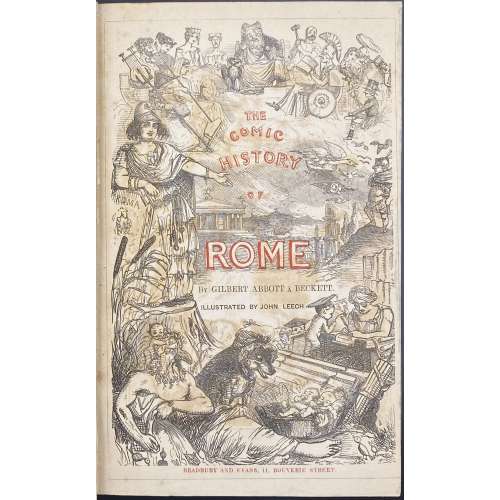
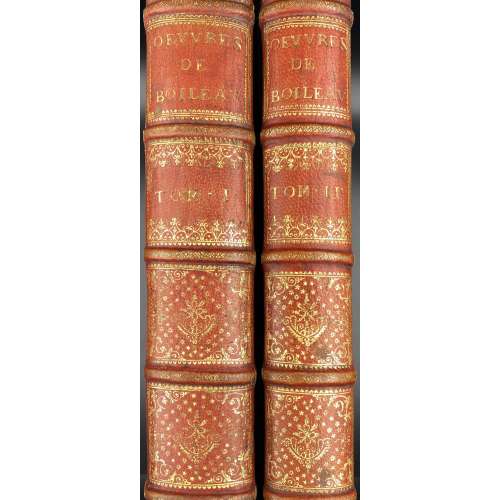
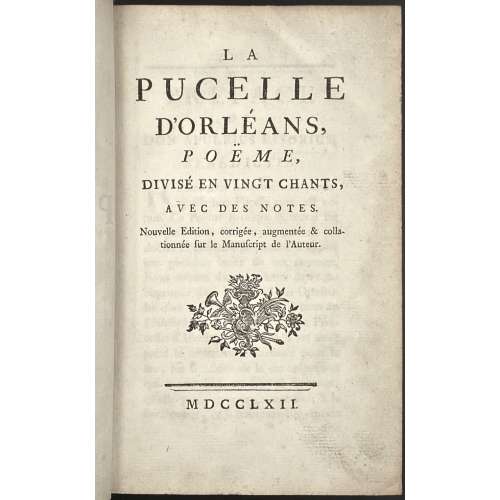
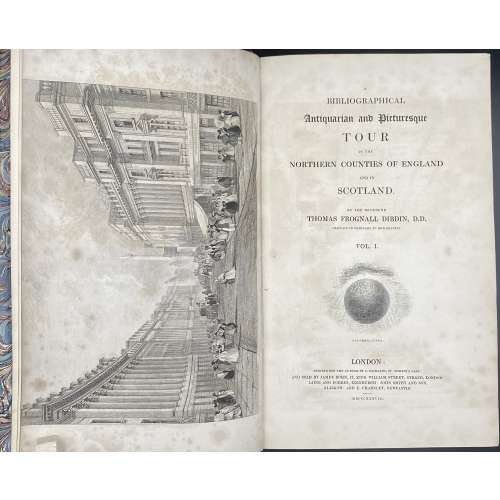
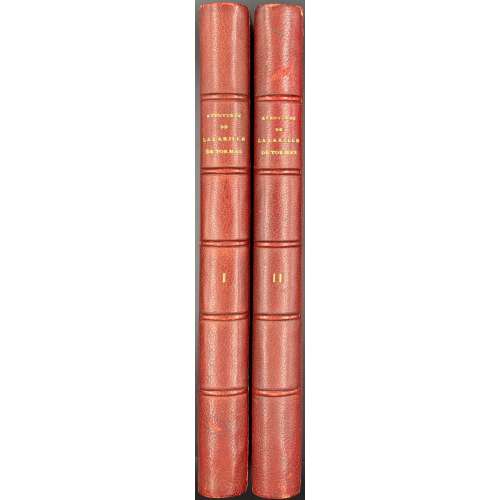
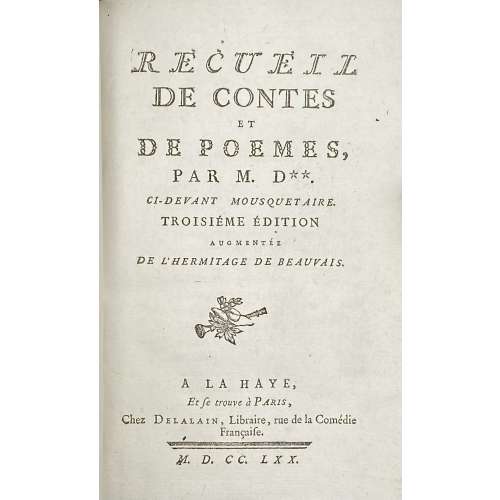
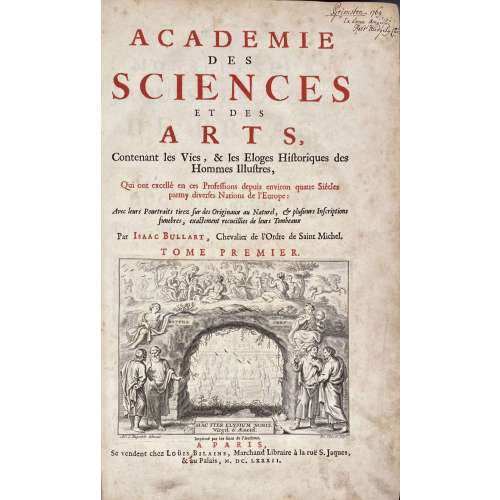
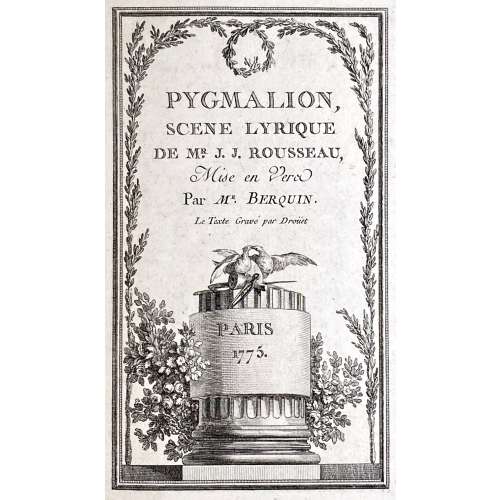
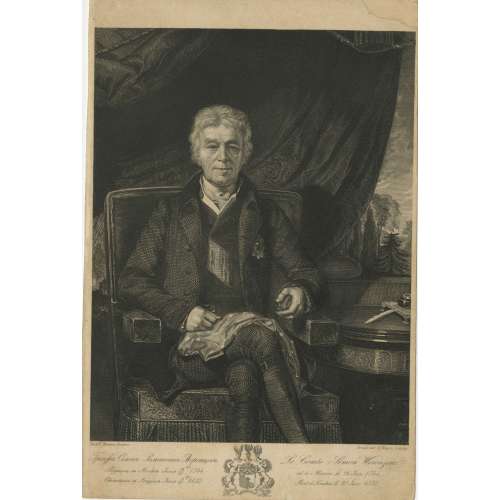
Seated portrait of Russian diplomat Count Semyon Romanovich Vorontsov (Семён Романович Воронцо́в; 26 June 1744 – 9 July 1832). Engraved by August Weger (Born: 1823 in Nürnberg; died: 1892 in Leipzig) from the portrait painted by Richard Evans (1784–1871). Circa 1825-50. Semyon Romanovich Vorontsov, the son of Count Roman Illarionovich and Marfa Ivanovna Surmina, was born on June 15, 1744; Active Privy Councillor; Ambassador to Venice and London from 1784, for over 20 years. Died in London on June 26, 1832.
Inscription: Графъ Семенъ Романовичь Воронцовъ. Родился въ Москвѣ Iюня 15-го/26 1744, Скончался въ Лондонѣ Iюня 9-го/21 1822. | Le Comte Simon Woronzow. né à Moscou le 26 Juin 1744, Mort à Londres le 21 Juin 1832. | Richd. Evans, Peintre. - Gravé par A. Weger, Leipzig. Vorontsov family coat of arms in the middle.
Dimensions: 23 x 15 cm. Ref.: Подробный словарь русских гравированных портретов Д. А. Ровинского, том. 1, 534-540.![[Voltaire]. La Henriade, nouvelle édition / 2 Vol. — Paris: la Veuve Duchesne, Saillant, Desaint, Panckoucke et Nyon, [1769]-1770.](https://varshavskycollection.com/wp-content/uploads/2021/02/LIB-2581-1.2020-1-4-500x500.jpeg)
